#how to make up for protein deficiency
Explore tagged Tumblr posts
Text
the mentally ill anguish of not wanting to keep hurting people and being a judgmental asshole but also not wanting to turn into a robot and slowly destroy my health with meds
#mentally ill#meds#meds are important for a lot of things but I just really don't like the way it makes me feel#but then I feel like an asshole if people tell me to take meds so im not abusive#I wanted to prove I can do it myself#and I probably can once I get more land and good crops from good soil#magnesium deficiency is a huge cause for anxiety#hangry#I really just need vitamins and protein and minerals#but there's not a lot of that in modern food#I want to just hang in there until I reach that place#but how many more times am I gonna fuck up before then?#every time I have an issue it just becomes a bigger threat on my mind that I cannot improve myself and I really do just need to shut up and#medicate myself until I cant think anymore#although I have been improving#tbh today's problems were caused by lack of sleep and food#I really have been getting better at preventing issues but not really#im getting better at hiding discomfort#but I should work more on calming down in the moment#first world problems#boohoo me and my miserable little mind#I feel so ungrateful but I also know that's not what I mean#I am lucky to have a family that didn't split#it was still painful to see how little they got along#but the stability is definitely a privilege#im an entitled piece of shit#no but im still kinda sad
0 notes
Text
Some notes under the snacking issue of Sebastian post caused my brain to weeoweeo it way too much than I expected, so well here are the continuing of topic xd
Sorry it's an essay because I can't write succinctly
1. How did the evil corporation(insert it’s name please) feed?
As far as I’m concerned, the shady corpo experimented on him to check/make people to able to breathe under water. Keeping him alive was quite crucial to success so I think they would provided him with proper amount of of food or at least the full nutrient content preparation. However, it changed when his body started to rapidly mutate, grow and evolve into what he’s now. The vast increase in his need of food and the fact that the gills didn’t develop very well, due to the scientists not very smart move - mixing his DNA with atmospheric oxygen snake and whale, caused the team to shrink his portion and gave him bare minimum in form of drip-feed… Auch
2. How didn’t he die from literally any nutrient deficiency sickness?
As I said it before I do not know the lore very much only basis. So forgive if I mess up some facts about the events. Going back to topic, after the event of beating the life out of his guards/special troops everyone left the lab immediately. Leaving everything behind including the rations, which were sent there for the staff to eat, all kind of medicine - pills, drops, syrups, injections etc. and whatever crops left( no idea if in the game is any „farm” but the transport would be extremely expensive so I think they would love to slash costs especially when there are vertical farms which are efficient, cheap and easy to maintain and during evacuation they could simply destroy it if nothing like this exists there). He simply gain most of crucial elements via all those supplements. Especially via drips which are the least painful without activating all digestive track. I like to think the reason why his extra arm is in the bandages is the fact that he often injects himself with various needles and his veins are in horrible state. At some point point all these supplements will end and it won’t end well for him, but not yet. That’s solves a bit the issue of lack of scurvy, nyctalopia and any other issues alike. Here’s the misery fish and his banana bag of lovely Zn and vit C
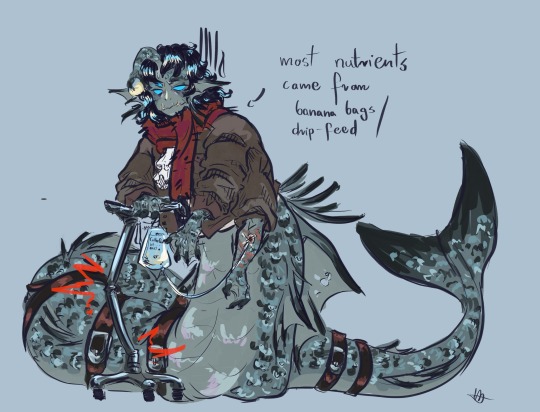
3. Another snacking issue
He is in constant state of hunger. No escape from it. The small human stomach ruthlessly dictates the size of his next snack and for how long he cannot eat, because it’s full, but it’s better to have at least one full than none. That could cause another big issue which is connected with the unconditional reflex - food in mouth equals activiting the synthesis of digestive enzymes and HCl in both tracks at the same time. Both are connected to one nervous system and the information goes to both, no matter if only one should start working. Not good situation, one belly is digesting itself,easy way to get ulcers or esophagitis, which not only are extremely painful but also deadly especially in his case with no health care or even chance to get any. He had to figure it out quite quickly how to make his eating as harmless as it’s possible. The easiest way I think would be simply some herby stomach drop, the one which highers the ph and stops HCl from being created. But I fear it works on human part- So he had to create strict timetable - when he eats, when he takes drops, when he can eat again. To keep the snake stomach in check and never letting it be fully empty and miraculously avoid the sinister autodigestive ideas of snake element. So his best friend is a tiny bottle of disgusting drops from a nurse office
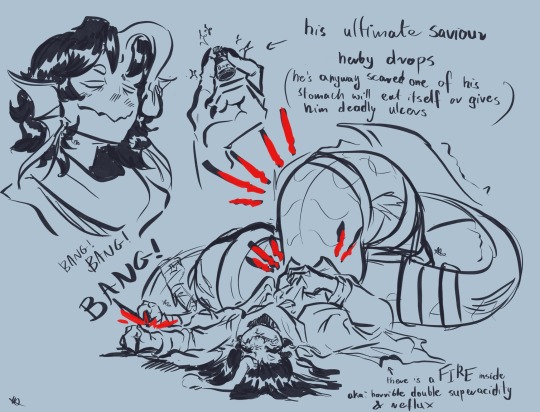
4. How not to starve to death with body like that?
Dense soup. Maximum proteins in the smallest velocity and in easy to consume and digest way. It passes both stomachs faster because tough long chains are already broken into smaller ones so it can be faster absorbed and used. It’s also very easy to make and can contain many ingredients giving the biggest diversity in one sip. Still starves because it’s not enough, but there is no better way :”)
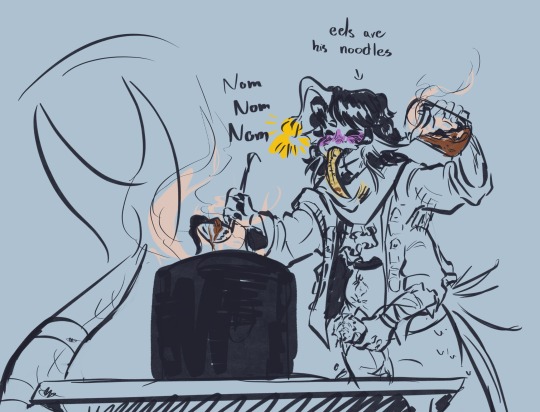
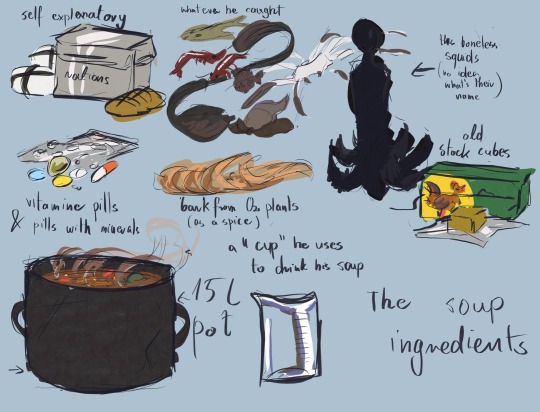
And no he wouldn't threaten anyone that he would add them to his soup. He was a human and he exactly knows there are too many weird fellas out there. No way he'll risk getting new traumatic event, he won't take it anymore-
The last thing is this two sentences:

Honestly I wasn't prepared to read something like this with straight face at 6AM. It wasn't in my weekly bingo card, but jup it made my day, thanks
#sebastian solace#roblox sebastian solace#sebastian pressure#pressure sebastian#sebastian#roblox pressure#pressure fanart#the pressure#pressure
248 notes
·
View notes
Text
gimli headcanons:
likes doing laundry. finds it soothing
history nerd!! loves reading old tombs/biographies of his ancestors
is incredibly intelligent. beats frodo in chess. would beat gandalf but gandalf cheats. has been in a stalemate with aragorn for two and a half years.
well mannered but chooses to forgo his politeness to make a point. especially around elves.
does NOT like horses. not just riding them, which is canon, but actually dislikes the animal itself. the reasons why include (but are not limited to) :
he does not like being not on ground. he does not have a fear of heights so much as a fear of… feet not on ground. as evidenced by refusal to jump, treehouses, and well, horses
he does not like their faces. they are long and have eyes on the side like prey. gimli thinks this is deceiving as horses are very large and can kick in someone’s skull. not his skull.
gimli believes that in a one on one match with a horse, he could easily win. he has thought of several, very specific, scenarios of this and has a detailed plan of attack should this situation occur.
they so easily turned against their home for an evil overlord (read: sauron stole all the black horses from rohan) and therefore cannot be trusted. as a rule, anything that willing you let you ride it cannot be trusted. they can’t be satisfied with this life. they are plotting something.
believes he would be great at drums. it’s just hitting things hard and he’s pretty strong.
ok, another thing about horses: they are fragile to a ridiculous extent. you breath wrong and it breaks. they have bad bones and bad blood flow in their legs, and their legs are all that they’re used for. he doesn’t understand why humans invested so much time into horses when they’re genetically bad at what they are meant to do. he’d feel bad for the horses if they weren’t so awful.
drinks coffee, not tea
takes great with the up keeping of his gear. he sharpens his axes, polishes his boots, shines his armor and waxes his mustache. that’s not gear, but he takes great pride in looking groomed and caring for his belongings.
has an axe for every occasion. battle axe? do you want throwing or slashing. a day on the town? have you seen this intricately carved masterpiece that also is a weapon? digging a hole? PICKAXE. cutting a cake? how about an axe???
hates the rain because it ruins his hair and beard. also loves the rain because it ruins legolas’s hair and clothes.
will eat anything. has a great tolerance for spice. contrary to popular belief, dwarves are not shy of seasoning but are very cautious around other races in fear of poisoning their friends
will also eat some rocks. salty is his favorite (halite, hanksite, glauberite) but also likes to add chunks of chalcanthite to his food for a slightly sweet yet metalic flavor. this is also slightly (SLIGHTLY) poisonous as evidenced by sharing his trail mix with boromir
also calls dirt the “local seasoning”
will taste dirt to try and get a feeling for the land. this tells him the acidity, weather, possible wildlife, and also pisses off legolas
actaully genuinely likes the taste of dirt. (note: if you desire to eat clay/dirt that is a symptom of iron deficiency. for gimli, he eats spoonfuls of the stuff like their supplements because as a kid it was fed to him like multivitamins)
OK SO HEAR ME OUT: lack of sunlight can cause really low hemoglobin and ferritin (a blood protein that contains iron) sooo being constantly in dark caves can cause some forms of iron deficiency. because dwarves are conscious of their young, dwarf children often grow up not often being in direct sunlight.
the solution? dirt. dirt contains iron and other tasty minerals that are good for the body. charcoal has natural antioxidants. so does clay. am i saying that momma gimli (unnamed) fed her son ash and clumps of dirt? yes. also bits of broken pottery. it’s good of the immune system.
fr tho clay/dirt/charcoal are the dwarven multivitamins. you have a tummy-ache? here, have a rock. i truly believe this was scientifically proven by dwarves and only FOR dwarves (plz do not eat dirt)
fuckin loves mushrooms. has a mushroom log at home. whenever dwarves find some fungai in a cave they go feral
likes dogs. thinks it’s great that they dig holes. thinks it’s fantastic that the bury things in holes. absolutes loves when they get muddy, and then shake off all water and dirt all over you.
when he came back home with the name lockbearer, a lot of the dwarves thought it was really cool and he has some sort of elven puzzle that requires a code to unlock something. imagine their surprise when he rocks up and is like: no, even better. HAIRS. three of them.
enjoys making mudpies- made them as a kid with his cousins, (mostly with rock slurry) and continues to, even even as an adult.
made them on the fellowship with the hobbits. taught them all about the best types of dirt and the water-to-soil- ratio needed.
while cutting up slices of his pie, he offered one to boromir, who in good nature, took it, clearly thinking it was just part of the bit.
poor boromir was locked in a stalemate after gimli cut his own slice, and began eating it.
to his credit, boromir did brave a few bites, but had to stop once he nearly had a mouthful of maggots
“protein”
gimli is like crazy good at hair. can braid quickly and efficiently in elaborate styles
picked up eleven hair style techniques in lorien (quicker than legolas) and was forced to relay them to the elf through twine as there is no way he’s letting grubby elf fingers to touch his glorious mane that’s been decades in the making
would ask for a drink “on the rocks” and get slightly upset if it did not come back with actual rocks
#lord of the rings#jrr tolkien#lotr#legolas#lotr headcanons#lotr gimli#gimli son of gloin#gimli#dwarves#lord of the rings headcanons#the lord of the rings#dwarf#and my axe#axes#jrrt#jolkien rolkien rolkien tolkien#middle earth#mines of moria#tolkien headcanons#misty mountains#gimli and legolas#gimli headcanons#the fellowship#the fellowship of the ring#moria#ered luin#durins folk#durins bane#gimli lockbearer#three hunters
216 notes
·
View notes
Text
i guess i had a longer post before but since i'm working on it now, a quick summary of hans' muscle composition

first is that they have a lot of explosive strength. their height and weight was confirmed as 170cm/5'7" 60kg/132lbs even before the anime adaptation, so it's true to how isayama imagined them. in the above scene that compares to pastor nick's height and weight of 192cm/6'3.5" 72kg/159lbs.
in the anime adaptation this action lasts a total of 1m14s.
35s - bearing initial weight. nick is still supporting himself and hans is not holding him that far from their combined center of mass. 22s - hans pushes him further over the ledge, increasing the distance of their center of mass from their body. this increases the amount of force that they must exert in order to hold him up. at this point hans' arm begins to shake, caused by their muscles beginning to alternate between fibers to distribute demand 17s - nick stops supporting his own weight, further increasing the amount of force hans has to exert to hold him up. killing him should not only be a mental question but also a physical one at this point
they then use the last of their strength to throw him back over the ledge. their entire body is shaking when they sit down.
the situation is somewhat unrealistic, especially hans' pose as regardless of their muscle strength they are at a major mass disadvantage and would absolutely have to place more of their own weight away from the ledge (this would naturally occur by widening their stance and lifting their unused arm on the opposite side) to avoid falling, but overall within the realm of possibility. regardless, it takes a lot of explosive strength to do something like this.

hans also has similar explosive strength on a few other occasions, notably when they kick over this table.
however in contrast, they don't seem to have much endurance

they're so exhausted from running presumably just a short distance from their horse to tell erwin that they drop to the floor lol. as if it were a regular occurrence, erwin just gets them a glass of water
so hans' endurance definitely doesn't compare to their explosive strength. which actually makes sense, considering two totally different types of muscle fibers control these types of movements.
the first type, which hans definitely has a large distribution of, are fast twitch muscle fibers. those ones use an anaerobic process to generate energy, which is also why they aren't breathing heavily after holding nick over the ledge, as their muscles used almost entirely anaerobic glycolysis to generate the energy required for the action.
the second are slow twitch fibers, used over longer durations. they use aerobic metabolism to generate energy, so this is why hans is breathing so heavily after running.
based on the disparity in their respective areas of strength, hans most likely has a higher distribution of fast twitch fibers. there is a certain gene which controls this, the ACTN3 gene. that one encodes alpha-actinin-3, which is a protein only expressed in fast twitch muscle fibers. allele variations control whether alpha-actinin-3 is actually encoded at all. individuals with a CC genotype have full expression of the gene, whereas CT or TT result in reduced production up to no production at all in individuals with a TT genotype. this is called ACTN3 deficiency. without alpha-actinin-3, muscles are shifted towards aerobic metabolism and fast twitch fibers work less efficiently.
it's actually very cool that hans' physical strength is so consistent in this way that we can even speculate on their muscle composition, up to them likely having a CC ACTN3 genotype. i haven't read much of isayama's blog but he used to post a lot about sports up to betting and predictions, so it seems like his particular athletic knowledge came into use here to depict them.
#hange zoe#wonder if yams referenced particular athletes for them#anyway this also means they would get colder faster and handle heat better
82 notes
·
View notes
Note
How do I truly become a pink Pilates princess on a budget?
Pink Pilates Princess 101
✧・゚: *✧・゚:* ✧・゚: *✧・゚:* ✧・゚: *✧・゚:* ✧・゚: *✧・゚:*
When I think of a pink pilates princess, I think of a girly person that romanticized their life in terms of wellness! a lot of people find the phrase annoying but i think it’s fun and cute! Here’s some things you can do to feel more like a pink pilates princess 💞
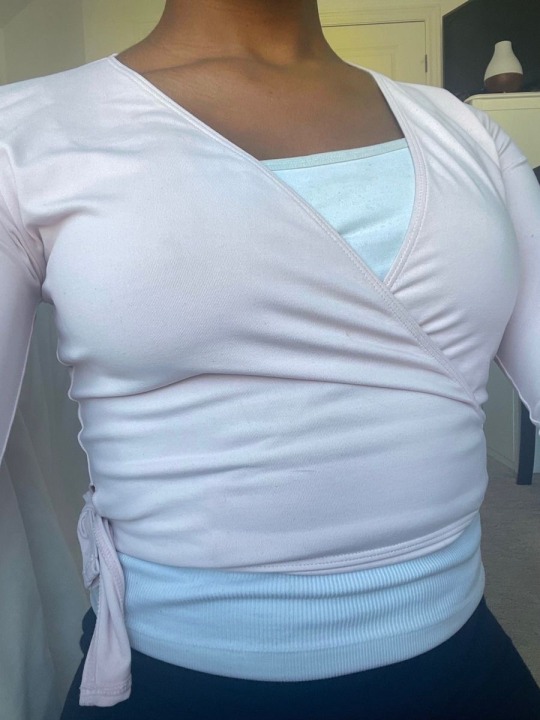
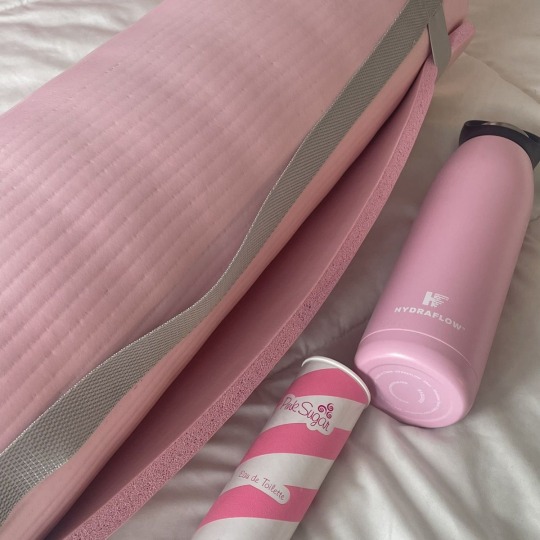

pic credit: all 3 pics from me posted on my pinterest @ nallyssajones
1. Doing pilates!
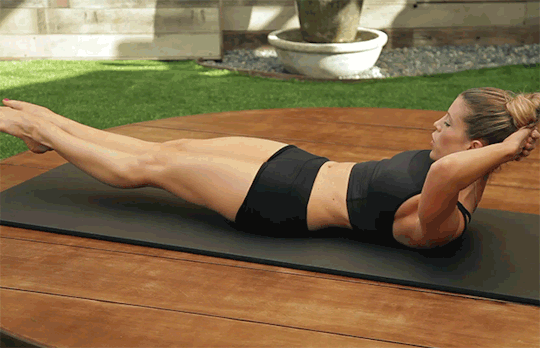
There’s mat pilates (only need a mat) and reformer pilates (using a reformer machine). Going to classes multiple times a week can be a tad expensive, so an alternative would be:
A) Signing up for paid subscriptions that have detailed classes for e.g; Alo moves, Pilates anytime, glo etc.
B) Following videos from youtubers that do mat pilates. My fave channels are; Move with Nicole, Sanne Vloet, Dansique fitness (she mostly does hitt pilates videos)
* Yoga is another amazing way to get movement in and feel connected to your body and spirit.
* Go on a hot girl walk! Going on mini walks around your neighborhood or even your house allows you to get some steps in daily.
2. Eating well!
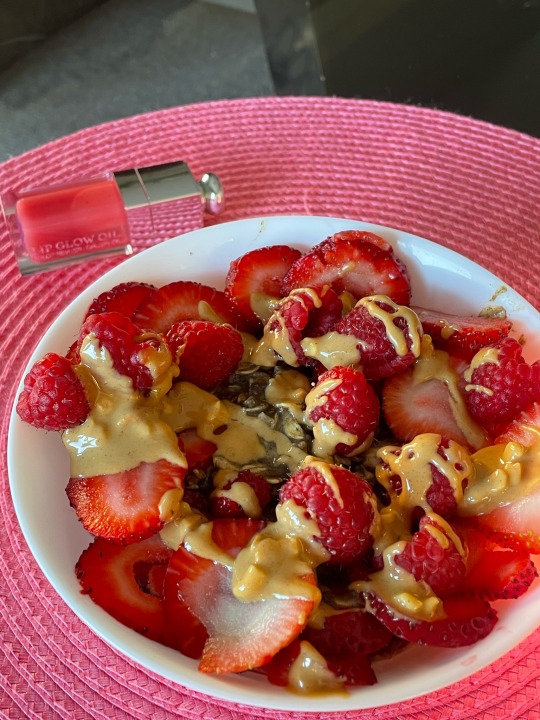
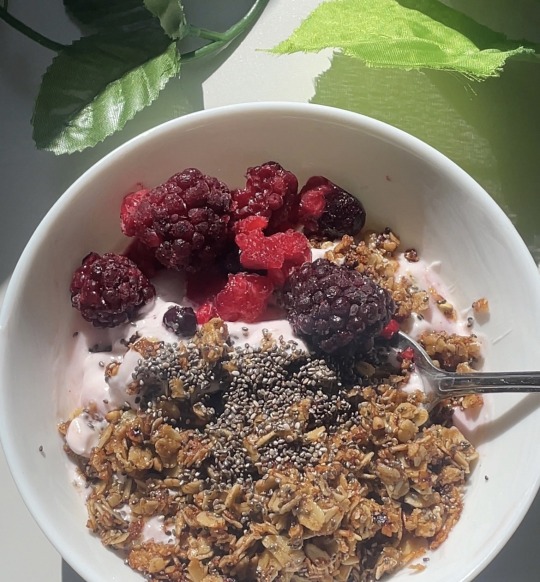
pic credit: my pics posted on my pinterest @nallyssajones
This is different for everyone but here are some ideas that you can add to your diet;
- Drinking green juice
- Try out yogurt bowls! It's my favourite breakfast food because it's easy to make and can be very nutritious depending on what I put into it. I like to add greek yogurt, a nice granola, matcha powder, frozen and fresh berries, pomegranate, ground flax and almonds🫐🍓
- Increasing protein intake. A lot of people have tried to eat 1 g per each lb that they weigh daily and have felt really good. My fellow anemic girlies, please increase your protein intake if you can!
- Taking your vitamins/supplements! get a blood test done to see what you’re deficient in and research supplements that might be helpful for you personally.
3. Finding cute workout+lounge sets

(pic credit: from @ lyssithadoll on ig and twitter)
Working out and going out in cute loungewear and workout sets can make you feel really nice and girly! I like to thrift nice quality brands like lululemon or even purchase specific pieces from depop and poshmark! Amazon is a good place to find sets as well but I would recommend buying high quality secondhand pieces💞 Some good brands to look out for are lululemon, alo yoga, halara and girlfriend collective.
4. Get cute exercise equipment

pic credit: my picture posted on my pinterest and ig @ nallyssajones
Get pink workout equipment if you’d like! Marshalls, dollarama, and amazon sell workout equipment that you can get for $5-$20! I got the pink fila mat in the pic above from marshalls for $19.99:) Here are some equipment ideas:
- yoga mat
- yoga strap
- wrist/ankle weights
- 5 lbs dumbbells
- gym bag
*these things aren’t needed btw! just ideas if you’d like to have more equipment.
5. Practice self care
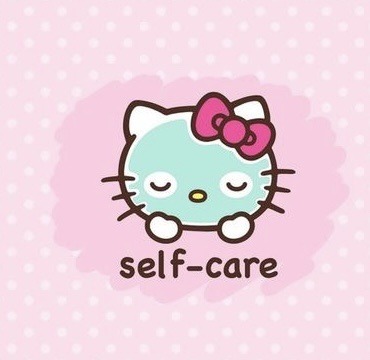

You can do whatever self care that you'd like but here are some examples that you can incorporate into your life:
- Take a relaxing bath (the book "ritual baths" has amazing bath ideas
- Engage in your favourite hobbies (sports, reading, watching a tv show etc.)
- Spend time with your loved ones
- Take care of your skin and have a routine down. You do not need 15 products but even adding a serum or a spot treatment to your routine can improve your skin!
***************************************************************************************************
I hope that you liked this post! This is all for fun and anyone can be a pink pilates princess 🧚🏾💞
#my pictures#my post#pink pilates princess#answered#girly girl#self care#wellness#prettygirlmission#my blog post#pink text
159 notes
·
View notes
Text
Also preserved on our archive (Daily updates!)
mRNA vaccines and infection miss the mark with your long-lived plasma cells (Aka the library of the immune system). That means you need to 1. keep up to date on your mRNA shots for best protection 2. switch to a protein-based shot (such as novavax) if you can. The protein delivery method seems to not have this same issue with long immune memory.
By Jon Cohen
Neither vaccinations nor immunity from infections seem to thwart SARS-CoV-2 for long. The frequency of new infections within a few months of a previous bout or a shot is one of COVID-19’s most vexing puzzles. Now, scientists have learned that a little-known type of immune cell in the bone marrow may play a major role in this failure.
The study, which appeared last month in Nature Medicine, found that people who received repeated doses of vaccine, and in some cases also became infected with SARS-CoV-2, largely failed to make special antibody-producing cells called long-lived plasma cells (LLPCs). “That’s really, really interesting,” says Mark Slifka, an immunologist at the Oregon Health & Science University who was not involved with the work. The study authors say their finding may indicate a way to make better COVID-19 vaccines: by altering how they present the spike surface protein of SARS-CoV-2 to a person’s immune cells.
Durability is an age-old bugaboo of vaccine designers. Some vaccines, particularly ones made from weakened versions of viruses, can protect people for decades, even life. Yet others lose effectiveness within months. “We really haven’t overcome this challenge,” says Akiko Iwasaki, a Yale University immunologist who is developing a nasal COVID-19 vaccine she hopes can be given often enough to get around the durability problem.
Just how long a shot can protect against SARS-CoV-2 is hard to assess because variants of the virus, able to evade existing immunity, frequently emerge. And new infections muddle attempts to assess vaccine durability because they provide a “boost” that keeps immunity from waning. Multiple immune actors also provide protection, including antibodies, T cells, and natural killer cells.
To get a clearer picture, the new study examined LLPCs, which are responsible for durable immunity to some other viruses. These cells, the offspring of B cells, primarily reside in the bone marrow. For some viruses, vaccination or infection generate LLPCs that can survive for decades, steadily producing “neutralizing antibodies” that can thwart new infections.
But not so with SARS-CoV-2, the new work indicates. Emory University immunologists Frances Eun-Hyung Lee, Doan Nguyen, and their colleagues enrolled 19 people who agreed to have their marrow aspirated, a procedure that carries little risk but can be painful because it means piercing bone. All had received between two to five doses of messenger RNA (mRNA) COVID-19 vaccines—which code for SARS-CoV-2’s spike—during the preceding 3 years. Five reported having had COVID-19, as well. The study subjects had also been vaccinated recently against influenza and had booster shots for tetanus, a bacterial disease.
Lee and her colleagues found that nearly all participants had LLPCs in their bone marrow that secreted antibodies against tetanus and flu. But only one-third had plasma cells generating the same defense against SARS-CoV-2. Even in those subjects, just 0.1% of the antibodies generated by their LLPCs were specific for SARS-CoV-2, an order of magnitude less than for tetanus and flu. “The paper is very informative,” Iwasaki says.
An earlier study of bone marrow from 20 people who had been infected with SARS-CoV-2 but never vaccinated against it also found that they were “deficient” in LLPCs specific to SARS-CoV-2 compared with those for tetanus. The new results “were really consistent with what we found,” says Mohammad Sajadi of the University of Maryland School of Medicine, whose team reported the data in the 25 July issue of The Journal of Infectious Diseases. “The big question is why?”
SARS-CoV-2’s surface features may offer an answer, Lee and her co-authors say. LLPCs emerge after “naïve” B cells encounter a virus or a piece of it, such as the spike protein. As B cells mature, they make more refined antibodies that better bind to the invader. After the initial infection, memory B cells continue to patrol the blood and a subset differentiates into plasma cells. Some of those cells migrate to the bone marrow, which provides safe haven for their long-term antibody production.
B cells carry Y-shaped receptors that attach to viral surface proteins when they identify a pathogen. If both branches of the Y bind to the same pathogen proteins, they trigger a phenomenon called “cross-linking,” Which spurs B cells to transform into LLPCs. But electron microscopy of SARS-CoV-2 shows its spikes are about 25 nanometers apart, too distant for a single B cell receptor to readily bind to two at once.
Spike doesn’t just appear on the virus itself; it also protrudes from infected cells and cells stimulated by mRNA vaccines. Electron micrographs don’t show the proteins and their spacing, but immunologists suspect the SARS-CoV-2 molecules are widely spaced on these cells, as well. As a result, Lee and her co-authors suggest, B cells don’t become cross-linked, and LLPCs don’t develop.
Other kinds of vaccines might present spike more effectively. Slifka points to an approved vaccine against human papillomavirus, which consists of a “viruslike particle” (VLP) made from surface proteins of that pathogen. Those proteins self-assemble into something that resembles a soccer ball. “That’s a very rigid structure with great spacing and it induces incredibly durable antibody responses,” Slifka says.
Martin Bachmann, an immunologist at the University of Bern, has argued that VLPs for SAR-CoV-2 could space spike molecules more closely���about 5 nanometers apart—than the virus itself. “I am personally convinced that viruslike particles are the best platform,” says Bachmann, who published his proposal in a 2021 npj Vaccines paper.
Given the dominance of current shots, bringing a new one to market won’t be easy. Indeed, Medicago made a spike-based VLP vaccine for COVID-19 that regulators in Canada authorized for use in February 2022, but the company stopped making it a year later because it lacked a market and went out of business.
The Novavax COVID-19 vaccine approved in the United States and some other countries uses insect cells to produce spikes that link together and form “rosettes,” which might offer tighter spacing of the protein and therefore durability benefits, but Bachmann doubts the rosettes work as well as VLPs. “Such poorly organized structures are clearly inferior to highly organized surfaces,” he says.
Lee would like to study the bone marrow of Novavax recipients for the long-lived plasma cells, “but there weren’t a large number, and it’s very hard to get patients to donate marrow,” she says.
Other COVID-19 vaccines in development use nanoparticles that display tightly spaced portions of spike. Neil King, a University of Washington biochemist whose team has developed one such COVID-19 vaccine now in human trials, says they do not have data on LLPCs or durability. “Spacing definitely matters, but it’s very difficult to set up controlled experiments,” King says.
Structural biologist Pamela Bjorkman at the California Institute of Technology, who has a similar nanoparticle COVID-19 vaccine in development, is more skeptical that spacing has a significant impact on vaccine’s durability. Influenza virus has tightly spaced surface proteins, she notes, and infection with it doesn’t lead to durable immunity.
Nguyen, however, thinks his team’s sobering findings require follow-up. “The bad news is the failure of SARS-CoV-2 mRNA vaccines themselves—with or without natural infections—to induce LLPCs in the bone marrow,” he says. “The good news is this failure itself provides a research opportunity to find a way to change the fate of short-lived vaccines.”
#mask up#covid#pandemic#wear a mask#public health#covid 19#wear a respirator#still coviding#coronavirus#sars cov 2
39 notes
·
View notes
Note
I went diabetic earlier this year, since then I've had far more serious health concerns to really focus on it. I've listened to my primary care and reduced my average a1c from 13 to 7. I've recently been looking into diets and what not that are the best. Currently, I'm trying to cut out all carbs, on my doctor's orders. What I'm seeing though is that a plant based diet is best. It looks like a ketogenic diet is what my doctor wants me to follow? I've watched videos on both diets and I don't know, I agree with you that keto is evil. What are your thoughts about this?
I am not a medical professional so i can't give you medical advice, but I'd say that you should ask your doctor for a referral to a dietician (an RD or an RDN, NOT a "nutritionist" - RD/RDN are protected terms that mean they have completed specific training and have specific board certification) and ask the dietician for advice on your specific dietary needs for your specific medical conditions.
What I can say is that trying to cut all carbs is pretty dangerous - not only is it a macronutrient that our body uses as the most available fuel for your body processes (we *can* get fuel from protein and fat, and ketones can *theoretically* replace sugars for energy but nobody is actually sure how long our bodies can do that and we know it's a LOT less efficient, it's supposed to be less efficient, and what that means is it makes a lot of people feel exhausted when they try it because they literally have less available energy) but also there are certain nutrients that are fortified in the US that are going to be hard to get if you're cutting carbs completely. The example that I always use is folate, because when I had to cut wheat out of my diet (i have grain allergies and celiac disease) I didn't know to supplement it and ended up with a form of anemia and stuff like "fainting" and "dizziness" and "low oxygen saturation."
Which is part of why massive diet changes should be undertaken with the assistance of a dietician! That's why I started studying nutrition! Because nobody supervised my medically necessary diet changes and it went very poorly!
Your GP very likely doesn't have a ton of training on nutrition, and is even less likely to have training on nutrition specific to your condition. If your GP is telling you to cut all carbs, they are telling you to do something dangerous and not nutritionally sound (even really restrictive keto diets call for 20g of carbs a day). Ask either them or your endocrinologist for a referral to a dietician (again, you are looking for a Registered Dietician or a Registered Dietician Nutritionist, RD or RDN, NOT just 'nutritionist') who is familiar with helping diabetics manage their nutrition.
Now, all of that said, in the choice between two fairly restrictive diets I will always say to try the one that requires less effort. It is much easier to eat a plant-based diet long term than a keto diet, and it is vanishingly unlikely that you are going to end up protein deficient (the primary concern for most people who are starting plant based diets, and it's just not all that likely - we need a lot less protein than a lot of people seem to think; though if you're going completely vegan you do need to be careful to supplement your B vitamins and to ensure that you're getting plenty of omega fats)
Because the thing is, for a diet to "work" you have to be on that diet forever. If you stop being on that diet, and stop adhering to its restrictions, whatever benefits exist for that diet go away. So the best diet for *anybody* is one that will provide them with the nutrients they need in a way that they can access regularly and affordably, that they enjoy eating and can comfortably maintain for long periods of time, and that includes a variety of fruits and vegetables because the only diet advice that is nearly universally applicable is that people should be eating more fruits and vegetables and they should be eating a wider variety of them.
I am not a fan of "diets" as a concept and I think that people should think of nutrition in terms of "my diet" not "the diet that is meant to be one-size-fits-all for millions of people that I am attempting." Your diet is what you eat and drink, and that is what you should be looking at adjusting. If you want to reduce carbs in your diet it's better to tweak your consumption than it is totally replace your diet with a one size fits all keto diet. If you want to increase fat in your diet it is better to tweak your consumption than it is to replace your diet with a one size fits all atkins diet. If you want to go plant based I think it is better to start by adjusting your diet to include more plants and to slowly replace animal based products than by trying a one size fits all vegan diet right out of the gate. You can always (and should!) make adjustments to what you eat as circumstances change and you may end up at a vegan diet or a low carb high fat diet and find that that works for you, but part of the reason that I think nutrition studies on diets are so screwy and hard to pin down is because your body is going to *flip the fuck out* when you change from, say, an average american diet to a study-provided Mediterranean diet for a 12 week experiment. If you drastically change your diet all at once and get good results immediately it's very hard to say if those results will be lasting because your body may just adjust to the "new normal" of your diet six months down the line.
But like seriously if your GP is telling you to cut all carbs you need to see a person who specializes in nutrition, and to prepare for your appointment with that person you should make a list of your goals (for you it sounds like you want to manage your blood sugar levels, reduce a1c, and *ask about* low carbs if that is something that interests you), a list of things you think that you'll have trouble with or that you want to include in your diet because they're important to you (if you really like nuts but have to be on a low fat diet, ask if there's a way to work around that with your needs, for example; if there is a cultural staple that you will find difficult to cut from family meals, TELL THEM THAT), a list of questions that you have about different types of diets, and *VERY IMPORTANTLY* information about your food budget and cooking skills. Be clear about it if you can't cook. Be clear about it if you can't afford certain ingredients.
Anyway. Once again, not medical advice, please speak to a medical professional, good luck.
194 notes
·
View notes
Text
I think often about how Thaddeus states in Episode 3 that he grew up on a farm, and more particularly on how he describes how it was like:
Transcription cuz I can’t get the actual clip myself:
“… [I] bet you, uh, seem some things, huh? Being a knight… I’ve seen some things [too]. I grew up working on a fly farm. I was a shitter, so they’d feed us and then they’d feed our shit to the flies. Mulch ‘em up and sell it as protein. Anyway, that’s why I’m so fat…”
And I think that scene is so fascinating…
//Warning for mentions of Child Abuse + Endangerment, Eating Disorders, & Unhealthy Self-Worth problems ahead.
First off, it shows Thaddeus trying to show “Titus” (Maximus) that he’s tough and not easily scared by, that he’s seen things just as bad and possibly worse as the Gulper they just faced, yet his voice trembles ever so slightly as he speaks. He wants Maximus to know that he is strong, but most of, but he also wants to bond with him.
And second off, by his tremble, whatever he’s seen isn’t something he doesn’t like to think of often. As if it’s painful connected into the next part of this story.
He very explicitly states he grew up on a fly farm, and by how he describes, it wasn’t the best environment for a child like him to grow up in. He (and others by the fact he uses “us” instead “me”) was forced to eat constantly, which likely led to him and his siblings to suffer from nutritional deficiency, dehydration, nausea, and one thing we know he got from that experience, an eating disorder that affects his body image. That environment of living on a farm whose sole income depended on you and your siblings eating as much as you can must have been rough…
He calls himself fat as well despite being thinner and lankier than Maximus and other squires his age, practically makes a joke out of it before getting sentimental about it for a moment of quiet thought, and throughout the episode he always offers up his food to Maximus and is never seen eating himself.
I also believe this is why he’s so desperate for safety and security of his wellbeing though out the show that he does anything to get, because if I was forced-fed and abused my entire childhood to keep working while you and your family barely make enough to survive in the Wasteland (and who are implied to have died at some point by his “rule of the wasteland” line later), I would also try to seek anything that didn’t put me at the bottom of the pecking order of the social hierarchy.
#fallout on prime#fallout#fallout tv#fallout tv series#thaddeus fallout#squire thaddeus#cw ed mention#cw child abuse#character analysis#character study#he’s so… interesting#deep down in his mind#he doesn’t say or do much but his actions speak VOLUMES to how he was raised
17 notes
·
View notes
Text
I'm watching the new season of Beastars. This season the school is undergoing segregation and society is more divided. As someone who studied ecology and loves reading up the natural history of animals. And likes to dabble here and there among the nutritional science of things. I have a major thorn about the series I have to address. Even if its a work of fiction, the knowledge I have is making me pause episodes far too many times.
And the issue is....the separation of Herbivores and Carnivores, the drug KINES and their reaction to it.
Most animals, even if classified as Herbivores can become omnivorous if conditions and situations arise. I've seen squirrels eat birds. I've seen deer on a nice warm spring day snatch up a goslings without hesitation, I've seen rabbits nibbling on deer antlers.
Many Herbivores especially during the winter and early spring will eat what is available, that includes bones, antler sheds, and sometimes even carrion, if there's nothing else. So how can you have a dedicated herbivore and carnivore? Why are cranes, chickens and peacocks among the herbivore group? HAVE YOU SEEN A CHICKEN HUNT AND SWALLOW A MOUSE??? Cranes and herons eat other aquatic animals.
The series integrates insects, milk and eggs as part of the diet. The majority of carnivores, Omnivores, Insectivores and Herbivores partake in these things.
Insects, milk, eggs, all come from a living being, and are animal products, or in the case of insects, are still considered animal protein. Sharing similar nutrients, minerals, proteins, fats and amino acids.
Therefore...The portrayal of the drug KINES is a bit flawed as that most of the inhabitants of the series have consumed animal products or animal proteins. Louis brings a chemical analysis and points out actin and myosin, both proteins present in muscle and cell movement, this includes insects. Louis says the report comes in as "trace" amounts, which means not alot. But remember...society regularly consumes dairy, eggs and insects.
Deshico makes a mention about there are GST's, during his demonstration of KINES between a carnivores who does not eat fresh meat regularly vs a carnivore who does. GST's is whole family of enzymes with a multitude of functions, some involved in digestion and detoxification in the liver. They are present in all tissues and organs, this includes insects. And if we use humans as an example....even life time vegetarians and vegans still retain the ability to digest meat, because some of the protease enzymes that are present during digestion are generalists, like pepsin, meaning they could break down the kale you ate AND the chicken you ate. Even wilder....there are some plants that can digest meats. Ever wonder why fresh pineapple makes your mouth tingle? That's bromelain in the juice, it breaks down protein, its digesting your tongue! So that's that's it. I don't have enough biochemical knowledge to tell you what would make KINES more believable for me. But as it stands, I would expect more species becoming MORE feral/addicted to this drink if regular consumption of animal proteins is all it takes and this is more or less addressing a nutritional deficiency of some kind. And if so, the society in this show is just okay with having the land carnivores and omnivores to be in a perpetual state of mal-nutrition and deficiencies..
17 notes
·
View notes
Note
how much should the average Gallifreyan be eating and drinking water? if they ate like the average human, would it have adverse effects? are there any nutrients Gallifreyans need that humans don't, or vice versa?
What does a Gallifreyan diet look like?
🌮Nutritional Requirements
Gallifreyans require a balanced diet much like humans, consisting of proteins, carbohydrates, fats, vitamins, and minerals. However, their advanced biology allows them to extract nutrients more efficiently.
🍕Nutrition: An adult Gallifreyan needs roughly the same amount of calories as a human (around 2000ish), but they process food so efficiently that one good meal a day is normal, so they appear to eat less.
💧Hydration: Due to their highly efficient kidneys, they need less water. Around two litres of water every day will keep them nicely hydrated.
⚠️Limits: They can go without any food for up to two weeks and up to five days without water before showing symptoms of starvation and dehydration, though they will get increasingly, err, tetchy.
👽Gallifreyan vs. Human Diet
If a Gallifreyan ate like the average human, it wouldn't be catastrophic, but there may be noticeable effects:
🍔Over-nutrition: Given their efficiency in nutrient extraction, consuming the same amount as humans would likely lead to excessive intake, resulting in unwanted weight gain. Their bodies simply don't need as much food to get the same nutrients.
🥤Hydration Overload: Drinking the recommended 2-3 litres of water daily might lead to more frequent urination and unnecessary stress on their kidneys.
🧇Cholesterol and Fats: Gallifreyans can metabolise fats without the negative effects humans face. However, an abundance of unhealthy fats could still challenge their otherwise efficient system over time.
🍫Special Nutritional Requirements
Good news for all the intergalactic nutritionists out there-Gallifreyans and humans have very similar nutritional needs. There are no specific nutrients unique to either species' requirements. However, there are some considerations:
🥛Low Sodium: Their kidneys are excellent at filtering, but a low-sodium diet helps prevent any unnecessary strain.
🍌High Protein and Enzymes: Due to their active metabolism and physical demands, Gallifreyans benefit from higher protein intake and foods rich in enzymes to support their robust bodily functions.
🥬Nutrient Imbalances: Certain foods, especially those rich in Vitamin K (like kale and spinach) and gingerol (found in ginger), could cause issues. Vitamin K can affect their blood chemistry, while gingerol will enhance the effects of other substances, making alcohol, for instance, much more potent.
🌟Special Conditions: In cases of illness or certain medical conditions, Gallifreyans might need to consume specific substances to correct nutrient deficiencies. This might include particular proteins or compounds not commonly found in a regular human diet.
🏫 So ...
So while Gallifreyans can survive on a human diet, their advanced physiology allows them to thrive on less frequent, nutrient-dense meals. So, if you're planning a Gallifreyan dinner party, think high-protein, low-sodium, and for Rassilon's sake, hide that ginger beer.
Related:
💬|🥗👽Are there any foods that Gallifreyans can eat that humans can’t?: What foods Gallifreyans could eat that humans don’t, with some theoretical examples.
💬|🥗🤮How do Gallifreyans vomit?: The process of emesis.
💬|🥗🍫How much sugar causes hyperactivity In Gallifreyans?: Overview of the sugar metabolism in Gallifreyans and theoretical limitations.
Hope that helped! 😃
Any orange text is educated guesswork or theoretical. More content ... →📫Got a question? | 📚Complete list of Q+A and factoids →📢Announcements |🩻Biology |🗨️Language |🕰️Throwbacks |🤓Facts → Features: ⭐Guest Posts | 🍜Chomp Chomp with Myishu →🫀Gallifreyan Anatomy and Physiology Guide (pending) →⚕️Gallifreyan Emergency Medicine Guides →📝Source list (WIP) →📜Masterpost If you're finding your happy place in this part of the internet, feel free to buy a coffee to help keep our exhausted human conscious. She works full-time in medicine and is so very tired 😴
#gallifrey institute for learning#dr who#dw eu#ask answered#whoniverse#doctor who#time lord biology#GIL: Asks#gallifreyan biology#GIL: Biology#GIL: Biology/Urinary and Digestive#GIL: Species/Gallifreyans#GIL
21 notes
·
View notes
Text
Jägermeister
Chapter Twenty: Making an Exit
“Newt Oji-chan is fighting the hive mind with the power of love?” asked Mako, after Hermann had succinctly summarized the drift, if one did not count all the stuttering.
He knew what Mako was thinking about. He had joined her and Newton for a couple of those magical girl cartoons, out of pure scientific curiosity, of course.
Hermann preferred Revolutionary Girl Utena, himself.
“So it would seem.”
Marshal Hansen crossed his arms. “So the logical next step would be…”
“Drift sex,” said Tendo.
“...Not what I was going to suggest.”
“No?” What remained of Tendo’s eyebrows performed a theatrical leap. “Darn. I've always been curious about that. My theory? It's over super quick. I'm talking: One Mississippi. Anyway, I guess that only leaves one option.”
“Oh?” managed Hermann.
“It's time to win your bet, brother.”
“Oh.”
Mako-chan had the gall to grin at him. “Once more unto the breach, Hermann Oji-chan.”
A number of respected medical and scientific professionals were gathered in the Hong Kong Shatterdome's Medical Bay to watch Hermann confess his feelings.
Hermann had lived most of his life by the rules of propriety, having been taught them at a young age and with little opportunity for independent experimentation. His difficulty replicating and reading social cues had left him feeling deficient in some way, until he met Newton, who could read dense scientific treatises, but could not read a room.
Newton must have been a terrible influence on him, for Hermann could not bring himself to give a fuck about the crowd gathered around them.
Hermann was seated in a chair next to Newton’s bed. A medic placed the squid cap on his head, and he resisted the urge to adjust it. Instead, he took Newton’s hand in his own.
Dr. Lightcap clipped her hair back, its gold now shot with streaks of silver, and the room went silent.
She counted them down. “Three… two… one.”
Hermann heard it simultaneously in Cantonese, like a bad bootleg dub. Then he was drifting with the hive mind once again, which was so overwhelming that it took him a moment to remember Newton was meant to be there too.
The reel of memories was jerky and awkwardly spliced together this time. Newton, getting his first tattoo, surprised by how little it hurt. Newton, using cold water to clean the blood out of his shirt because hot water would denature the proteins and make it adhere to the fabric. Newton, taking a scalpel to his own wrists.
Bugs wasn’t around. Instead, there was a nightmarish rabbit with twisted ears that Hermann could glean just enough from the drift to know was named Frank.
“Why are you wearing that stupid man suit?" asked Frank.
Hermann said nothing and followed the music until he was back in the theater. Monica Schwartz ignored him once more as he made his way backstage and on to the Hermann Cave.
Newton was curled into a ball on the floor, but he looked up when Hermann barged in, huffing and puffing out of pure expectation.
“You sure are getting around, Ghost Hermann.”
“This isn’t the ghost drift, Newton,” said Hermann, as soon as he had caught his psychosomatic breath. “I am actively drifting with you. I was doing so the last time as well.”
Newton froze so completely that, for a moment, Hermann thought he was being pulled from the drift again.
Then Newton’s mouth fell open, but for the first time in their not insignificant shared history, he seemed to be at a complete loss for words.
Hermann powered through the silence. “I truly am here to save you, though I do not know quite how to do it.”
Newton let out an unexpected burst of laughter. “Have you tried unplugging it and plugging it back in?”
“Stop it.”
“Come on,” said Newton. “We saved the world. You win some; you lose some.”
“Not you,” Hermann did not so much say as intone.
That seemed to stump him.
Hermann was not faring much better. This was infinitely harder than infinitesimal calculus. “Newton, you must be aware of my feelings for you?”
“… Irritation?”
“You bloody idiot,” said Hermann. “Surely you felt it in the drift? I certainly felt your affection, although I did not perhaps understand the ah, extent of it until rather recently.”
Newton winced, but that might have been due to the rising tempo of the hive mind’s tumult.
Hermann tried to find somewhere to look that wasn’t Newton or a wall covered with pictures of his own face.
Oh, or the ceiling.
Hermann settled on his knees.
“Your feelings are reciprocated, if that’s what you’re concerned about,” he told his knees. “I've been in love with you for most of my life.”
At first, Newton did not move, and Hermann once again grew concerned that they were falling out of alignment.
Then he started crying.
Hermann wondered if he could have possibly misinterpreted the Hermann Cave.
“Newt-”
“Okay, Boomer,” said Newton, and it was such a staple of their arguments that Hermann felt a sudden surge of Schrödinger’s nostalgia for something that was not yet necessarily lost.
“Don't call me that,” he recited. “I am only one year older than you, for heaven's-”
“Enough Tomfuckery.” Newton was still talking. “We- I admire your ambition, Allegedly Real Hermann, but it's not going to work.”
“Are you questioning my feelings?” Hermann interrupted Newton this time, perversely delighted to be arguing with him again. “Because regardless of your, no doubt compensatory, number of doctorates, I assure you I am the leading expert when it comes to my own mind. Now, you had bloody well better believe me, foremost because I am telling you the truth, but also because it is the only weapon we have to wield against the Precursors. I do not care how many worlds they have conquered. I will not allow them to take mine.”
Newton grabbed Hermann by the lapels as though he was going to throw him out of his own cave.
Instead, he went up on his toes and kissed Hermann directly on the mouth. It was chaste and very short, but despite the absence of cliched electricity, it still managed to completely rewire Hermann's brain.
When Newton attempted to pull away, Hermann reeled him back in by his ridiculously thin necktie and kissed him once more.
Newton froze again, and Hermann wondered if perhaps it had been a little too soon for tongue.
“Dear?”
“Oh,” said Newton, and then Hermann could feel it too.
The Precursors truly did hate love. He had never felt such roiling fury, not even in the wake of Operation Pitfall. Somehow, to the hive mind, this was personal.
“Oh.”
...
@lastdaysofwar
7 notes
·
View notes
Note
Wait if the human body needs fats for protein absorption, do you have any idea what someone who can't process fat at all is supposed to do? I'm currently being evaluated for all kinds of possible diagnoses but so far my physician isn't sure what's wrong with me and if it's curable, but the gist is that I literally can't eat anything even slightly fatty without becoming severely sick and immediately having to run to the bathroom. So I can't eat any meat that isn't lean, I can't eat cheese, can't drink milk, I can't eat yoghurt that isn't advertised as 0 fat, and I can't use oils at all either.
From what you're saying about fats, that sounds...less than ideal. Considering I don't know for how long I'll be forced to live this way or if there's anything that can fix it at all, do you know if there's anything I can do to prevent the rabbit starvation you speak of?
(referring to this post) Oh, wow! I’m sorry, that sounds frustrating and stressful.
I want to be clear: I’m an archaeologist, and my primary understanding of this comes from an archaeological and evolutionarily perspective, not a modern nutritional one. Your doctor and your nutritionist will know a lot more about your case than I do.
That said, rabbit starvation/protein poisoning is only really a concern when lean meat makes up the majority of your diet. Not the majority of the meat in your diet, the majority of your diet, period. It’s a topic of interest among archaeologists in particular because it would have been a perennial concern in the winters during the Ice Age: when hunting animals with lean meats would have made up a large portion of early humans’ and Neanderthals’ diets during a Paleolithic winter. Historically, this tends to happen only in the winter in tundra and subarctic regions when grains, fruits, vegetables, nuts, and fish aren’t available. There’s a reason it’s also called mal de caribou.
Carbohydrates, sugars, fruit, and vegetables give you a much more balanced diet and help make up for deficiencies in other areas. And modern nutritional supplements, fortified foods, and multivitamins also help stave off many historical areas of malnutrition. If you are eating a modern spread of foods, even without fat, you are very unlikely to get protein poisoning. You might get constipated when you eat the meat, though.
My understanding is: proteins get digested faster than fats. So if you eat high-protein lean meats, they can move through your system quickly, without your body having time to extract all the amino acids and all the nutrients from them. And then the undigested bits can build up in your colon and make you feel constipated. Fat is digested more slowly, and when eaten with protein, allows your body more time to extract more and fuller suite of nutrients from the protein. Possibly there is also an emulsification aspect going on as well, I’m not positive and it’s hard to find good explanations that aren’t diet-culture-focused. (Fat also does other important things in your body with providing long-term slow-burning energy, padding your organs so they don’t impact against other parts of your body, and absorbing fat-soluble vitamins and such; again, I’m not a nutritionist, and I don’t super understand the details.)
But dietary fiber can also slow down digestion, and can help give some of those same digestive effects. (Nixtamalized) corn+beans+squash is a very traditional diet of the Americas because it gives the whole suite of necessary amino acids without requiring a whole lot of external additions. Also, I get the sense that fish like salmon work differently because of omega-3 fatty acids? So there are for sure things you can supplement with.
My post wasn’t intended to make people worry; modern nutrition and food availability means that there is a lot of flexibility you can have in your diet if you’re allergic to one aspect of it. It was meant to say, even “unhealthy” fats have an important place in a balanced diet, and can do good things for you besides just tasting good, and that craving it may well mean there’s something in there that your body wants. But if fat genuinely isn’t good for you for medical reasons, there are absolutely ways of dealing with that. Ultimately, variety is the most important part.
#I AM NOT A DOCTOR#I want to make it clear that my understanding comes from an archaeological place#And the evolutionarily needs we developed as humans#Definitely ask your doctor or a nutritionist how to stay healthy#But I really don’t think you need to worry about rabbit starvation if you are eating plenty of grains and fruits and vegetables as well#asks#featherymainffins#Good luck though that sounds stressful
13 notes
·
View notes
Note
How do I actually stop eating meat. I have been trying to go full vegan for 6 months and there will be times were o feel so close but the craving will be back and it will get so strong that I cave. I feel terrible after, promise myself it will never happen again but the craving comes back and am juts in a cycle, I feel embarrassed to say but it’s like an addiction and I don’t how to stop. I don’t feel vegans ever talk about this
Cravings are very common, especially in the first few months, and can be caused by anything from lack of sleep to dehydration, stress, nutritional deficiencies etc. Strong cravings however are a good indication that you're not getting something you need, meat is a good source of protein, salt, fat and calories, so make sure you're eating enough of all of those. This is your body looking for something specific, and you can find that something in food products that don't contain animal products.
Explore faux meat options, many of which are so realistic and so nutritionally similar that they'll likely hit the spot. Also try out dishes with tofu, seitan, tempeh etc. which are good, satisating proteins that serve much the same function. Add more to your diet as you take away, otherwise it'll only feel like a loss. You need to develop a range of plant-based dishes you can make and enjoy, I'd focus on that first and foremost.
As for the 'how,' I'd recommend transitioning slowly. You can do this by meal, so you'd get vegan breakfasts nailed, then lunch, then dinner, then snacks etc. Or you could do this based on one product at at time, eliminating the easier ones earlier. Or you could have days where you eat entirely plant-based, and days where you don't, based on what works with your schedule. These will all serve to dampen some of that initial 'shock' and hopefully get you used to what and how much you need to be eating to not crave meat so much.
Some people still get cravings years in, but it's rarely strong ones, and you learn to recognise what it is you actually need and how to manage them. It's a bit like when you crave fatty fried foods after a night of drinking, but you know that all you actually need are healthy fats and plenty of water.
It will get better over time and you'll find your own ways of dealing with it, but beating yourself up over it shouldn't be one of them. Keep trying, if you slip up just move forward, you haven't 'failed' veganism you've just had a moment of weakness. It’s a process, it’s not something many people can decide to do then immediately get it right every time. You're not starting over when you fall short, you just had a bad day but the next day can be better. Stick at it and you will get there.
26 notes
·
View notes
Text
The Ordinary Rosehip Oil: A Detailed Look at Its Benefits
In this article, we will examine the many benefits of Ordinary Rosehip Oil and how it can enhance your skincare regimen.
With just one core ingredient—rosehip oil—it’s simple and effective.
Let’s dive into how this oil is sourced, its key benefits, and what it can’t do for your skin.
How The Ordinary Rosehip Oil is Extracted
Rosehip oil is sourced from the seeds of the Rosa canina plant. The method used to extract the oil is crucial in preserving its potent active ingredients and ensuring its optimal performance.
The Ordinary employs a cold-pressing technique to extract the oil, which avoids heat and helps maintain the oil’s full potency. This method ensures that the oil’s beneficial properties are preserved, preventing degradation from heat.
The Benefits of The Ordinary Rosehip Oil
Rosehip oil is famous for its range of skin benefits, making it an excellent addition to your skincare routine.
1. Brightens the Complexion
Rosehip oil brightens the skin in several ways:
Anti-inflammatory Properties: Rich in anti-inflammatory compounds, rosehip oil helps calm irritated skin and reduce redness. Inflammation often leads to an increase in melanin production, which can cause dark spots and uneven skin tone. Rosehip oil helps to prevent these issues and can brighten the complexion over time by soothing inflammation.
Linoleic Acid for Skin Barrier Strength: One of the main components of rosehip oil is linoleic acid, a fatty acid that supports the skin’s natural barrier. This helps keep the skin hydrated and prevents moisture loss. When the skin barrier is compromised, it’s more vulnerable to dryness, irritation, and breakouts. Linoleic acid strengthens the barrier, resulting in softer, hydrated, and radiant skin.
Retinoic Acid for Skin Renewal: Rosehip oil contains retinoic acid, a powerful anti-ageing ingredient. Retinoic acid speeds up cell turnover, removing dull, dead skin cells and revealing fresher, more youthful skin. This process helps brighten the skin and even out its tone.
2. Helps with Acne-Prone Skin
Rosehip oil can be particularly helpful for those with acne-prone skin. Here’s how:
Unclogs Pores: Acne occurs when pores become blocked by excess sebum (skin oil) and dead skin cells. Studies show that sebum in acne-prone skin is often deficient in linoleic acid, making it stickier and more likely to block pores. Rosehip oil, which is rich in linoleic acid, helps to thin out the sebum, making it less likely to clog pores.
Reduces Dead Skin Build-up: The retinoic acid in rosehip oil promotes quicker skin cell turnover. This helps shed dead skin cells before they accumulate and clog pores. By keeping pores clear, rosehip oil can help prevent breakouts.
Regulates Sebum Production: Overproduction of sebum can contribute to acne. Rosehip oil helps regulate this process, balancing oil production. This makes it beneficial for those with oily skin who are prone to excess shine and breakouts.
3. Anti-Ageing Properties
Rosehip oil is also recognised for its anti-ageing effects, largely due to its retinoic acid content.
Boosts Collagen Production: Collagen is the protein responsible for the skin’s firmness and elasticity. As we age, collagen production slows down, leading to sagging skin and wrinkles. Rosehip oil stimulates collagen production, helping to promote firmer, younger-looking skin.
Improves Skin Texture: By increasing cell turnover, rosehip oil helps smooth the skin’s surface, reducing the appearance of fine lines and wrinkles. Over time, this results in a more youthful and radiant complexion.
Texture and Suitability for All Skin Types
The Ordinary Rosehip Oil has a light, non-greasy texture that absorbs quickly into the skin. This makes it ideal for all skin types, whether you have oily, dry, or combination skin. It’s also gentle enough to be used under makeup, leaving the skin with a soft, luminous finish.
What The Ordinary Rosehip Oil Can't Do
While rosehip oil has numerous skin benefits, it’s important to be aware of its limitations:
Doesn’t Add Hydration: While rosehip oil helps prevent moisture loss by strengthening the skin’s barrier, it doesn’t directly hydrate the skin. For added hydration, consider pairing rosehip oil with a serum that contains humectants, such as hyaluronic acid.
Won’t Cure Acne: Rosehip oil aids in unclogging pores and preventing breakouts, but it doesn’t target the bacteria responsible for acne. It works best when used as part of a broader skincare routine, alongside products that fight acne-causing bacteria.
Not a Replacement for Exfoliation: While rosehip oil helps with cell turnover, it’s not a substitute for exfoliating acids like salicylic acid or lactic acid. These chemical exfoliants are more effective at deeply cleansing pores and removing dead skin from the surface.
Not a Full Substitute for Retinoids: Although rosehip oil contains retinoic acid, it doesn’t offer the same powerful anti-ageing effects as a retinoid serum. For more noticeable results, consider combining a retinoid product with rosehip oil.
Conclusion: The Ordinary Rosehip Oil
The Ordinary Rosehip Oil is a simple yet powerful product, featuring just one ingredient. It’s an affordable addition to your skincare routine, offering multiple benefits, including brightening, acne prevention, and anti-ageing effects. However, it doesn’t add hydration on its own, so it should be used as part of a complete skincare regimen.
When to Apply Rosehip Oil
Plant oils like rosehip oil are best applied at night. During the day, plant oils can interfere with sunscreen, essential for protecting the skin from UV damage. At night, rosehip oil effectively repairs and rejuvenates the skin.
Final Thoughts
Overall, The Ordinary Rosehip Oil is a great product to incorporate into your skincare routine. It’s affordable, effective, and suitable for all skin types. If you aim to brighten your skin, reduce acne, or combat signs of ageing, rosehip oil is definitely worth considering. Below is a video on my YouTube channel about this:
youtube
4 notes
·
View notes
Text
hello! welcome to blog post #2! i was real stoned while writing that last post so ive been reading it a lot to make sure i said everything right. it made me think today about “eating healthy for cheap…” i mentioned lots of canned and frozen foods because i had fruits and vegetables in mind, but i want to clarify that senshi needs more than just fruits and veggies and WE DO TOO!! senshi complains about adventures meals commonly avoiding fruits and vegetables, and is persistent about the importance of a BALANCED meal. just like he said- you need fats, carbs, fruits, veggies (and more)!
i see people now are far too worried about how much protein or calories they’re getting, and health blogs barely ever mention vitamins anymore. nobody wants to talk about the yucky stuff, like fiber and digestion. digestion is easily one of the most important functions in your body (i believe) and you can do a lot for yourself by taking care of it!
since a lot of my health issues have been centered around my stomach and my vitamin levels, i focus on fiber. but if you live in america, you should too because you’re at risk of having the same deficiencies i have! 🫵 most americans don’t meet their fiber goal daily, and many people struggle with constipation as a part of their daily life. that will make you grouchy and more easily overstimulated + tons of other stuff!!! for some people and in my case, your body won’t always digest stuff right if there’s not enough fiber and you may not absorb the nutrients you’re eating. it’s actually recommended to try and consistently get vitamins from your diet and not pills, because you absorb it better when you eat it (just like the medicine senshi said worked better when cooked!) that’s also why it’s so important to hit all your food groups. carbs aren’t an issue, btw- you just need to make sure you’re eating healthy grains. i have a gluten allergy so i actually make most (hopefully all soon) of my carb foods from scratch (waffles, bread, pasta) which gives me more opportunity to pick what grains i get. not everyone has time to bake from scratch though, so oatmeal, wild rice, and popcorn are all some great cheap/easy grains to get in you!
(here’s the mayo clinic guide to grains. they have a guide about fiber too i can send to anyone interested. i’m a patient at mayo with their gender clinic team and i trust them as a resource, but don’t forget to talk to your nutritionist or doctor to figure out what you need and what would be best for you. don’t be afraid to ask them questions, it’s their job!)
you should be getting good fats too. avocados/avocado oil, olive oil, and oily fish like salmon are all some great examples of healthy fats. if you like to bake and you’re up for a challenge, i made butter-free cheese danishes for a friend this year using avocados as fat in the pastry dough!
probiotics can be found in things that are fermented, like yogurt or even olives and apple cider vinegar.
when it comes to meat, i know some people say red or white is healthier, but i cannot stress the importance of talking to your doctor about it!! people with certain medical conditions or allergies may not be able to eat certain meats, and there may be some meats that you should be eating MORE bc of your body or genetics. if you don’t eat meat or only eat red or white meat for any reason, let your doctor/pcp know so you can figure out if you need supplements.
when it comes to fruit and vegetables i get a wide variety since they’re easiest for me to put more of while i cook, so i honestly haven’t checked out what vegetables i SHOULD be targeting. however, when i buy fruit i aim for things high in fiber to help me hit my fiber goal (like oranges!) or i buy fruit that helps with anti-inflammatory stuff. i don’t remember what about the fruit/berries helps but i aim for blueberries and pomegranates. pomegranates really aren’t messy if you open them in a bowl or strainer under running water, and they can be as low as $1 some places for maybe 1/3 cup of seeds? not bad!
but anyways, that’s pretty much all i know so far. becoming informed about what your body needs can open up a lot of new dietary options for you that are still affordable. getting a balanced and nutritious meal should be more accessible but just like senshi we can help, encourage, and educate ourselves and our friends to build a better community. let’s figure out the right path to affordable and sustainable health, together!!
love, senshi’s #1 fan
#if you can reblog this with things YOU know about digestion or food that would be awesome#luneski blog post 2#delicious in dungeon#senshi#senshi dungeon meshi#dungeon meshi#senshi tips#life tips#health tips#diet tips
4 notes
·
View notes
Text
so beauty tips from me to you.
Animal fat = GOOD!!!
Healthy and beneficial for your body, skin, mind and overall health and wellbeing. Healthy animal fats will nourish you inside and out. Examples of incorporating these healthy animal fats into your diet would be swapping semi skimmed milk/ plant based milks for whole milk (lactose free if that is an issue), processed cheese swapped with real cheese and red meat/ poultry as protein in whatever meal of your choice etc. i know a lot of diets and health plans/ restrictions will prevent alot of people from eating or using animal products, i don’t blame you for this, what i will say is definitely do research on supplements and real substitutes that will provide your body with the same/ very similar nutrients. cutting these kinds of healthy and important fats from your diet can cause deficiencies etc.
Exfoliating in the shower/ bath:
There is nothing better than feeling, smelling and above all BEING clean, the best and safest way to do this is to exfoliate the dead skins and germs from your skin on a regular basis- by this i mean 1-2 times a week but not every day- to ensure healthy, bright, smooth and squeaky clean skin. You can exfoliate using gloves, scented sugar scrubs and or brushes or stones. i will admit my own faults with this, i have been known to over-exfoliate my skin, using harsh gloves, scrubs and brushes on an everyday basis which eventually caught up to me in sensitive, harsh and very easily ripped and cut skin, so don’t be like me.
on days where you do not want to exfoliate i recommend you start by washing your hair and then doing your body afterward to make sure no residue is left on your skin, potentially causing breakouts like bacne. you can use a soft and light wash cloth with a bar soap, then a liquid cleanser of any scent you prefer (i love coconut and milk!!!) and then finish off with an unscented cleansing body wash around your more sensitive areas, ensuring all soaps and washes clean your body EXTERNALLY!!!
Body butter, oils and moisturisers:
After showers while your skin is still damp, apply a body oil to your skin. i like using Bio-oil as it has skin healing properties like reducing scarring and *apparently* reducing the visibility of stretch marks. the reason is that oil will lock in that moisture in your skin, leaving you with a beautiful glow and silky smooth- and maybe you’ve just shaved too- this will also lock in that sweet sweet post shave softness all day long.
Once your oil is applied, you should go in with a scented moisturiser. if your skin is too sensitive for scented moisturisers or body butters i recommend using baby lotions, they’re a lot softer on the skin and there is a faint baby powder smell that will leave you smelling fresh without that added irritation. i recommend using a scented moisturiser that matches the scent of your body wash, for me that is coconut/ vanilla. this is to really enhance that smell on your skin and really make it your signature and ‘natural’ scent. lotion/body butter will also lock in moisture while adding in some beneficial elements of its own, i recommend applying some to your armpits and then spraying some deodorant on right after, to me this allows it to last longer.
Hair and skin
Get to know your skin and your hair, spend some time playing around with a mirror and analyse your hair texture, how oily or dry your skin is, what shape your eyes are, the length of your hair etc. All of these beautiful jigsaw pieces that make you uniquely beautiful, get to know them and understand them, this way you can correctly enhance their individual powers and create looks based on what YOU need. i don’t have much experience with curly hair as i have very straight hair, there are many blogs and websites available to tell you what hair type you have and how to care for it correctly. what i will say is using hair oils in the bottoms of your hair and a heat protector before applying head to dry/ style seems to work wonders for the shine of my hair.
as for skin, knowing your shade, how oily or dry it is, what colour of blush compliments your skin tone, what colour of eyeshadow compliments your eye shade etc will enhance your beauty by stars and stars!!! all of these unique qualities on your face are yours to learn and love, to build upon and allow to shine, these are all things that take time, experience, trial and error and above all, confidence to try. no one knows exactly who they are, what they like, what suits them and what doesn’t first try, it’s up to you to take the leap and also take feedback and constructive criticism- without letting people insult you- ask a friend what they think about your lipstick shade, or about your eyeshadow that day. sometimes it really does take a village to built confidence and understanding, even about your own self.
the last thing i will mention about hair and skin health and hygiene is making sure they are clean and free of harsh chemicals, dirt and grime for long periods of time. bathing and washing up frequently are important, double cleansing your face and removing all makeup before bed, and finally changing your sheets every 1-2 weeks- i know it is a task that is boring and time consuming but i promise it is absolutely worth it and so good for you. i recommend buying beautiful sheets and quilts that speak to you and motivate you to change them frequently- your hair, skin and overall hygiene will thank you for this.
That’s all for now sweethearts, let me know if you would like more of this from me or any beauty tips you have in the comments!!! i absolutely love hearing other peoples personal beauty secrets and advice!!! lots of love 🫧

#coquette#angelcore#dollcore#beauty#beauty tips#cleancore#bathtub#exfoliation#healthylifestyle#healthyliving#self love#personal hygiene#smell good#how to feel beautiful
3 notes
·
View notes